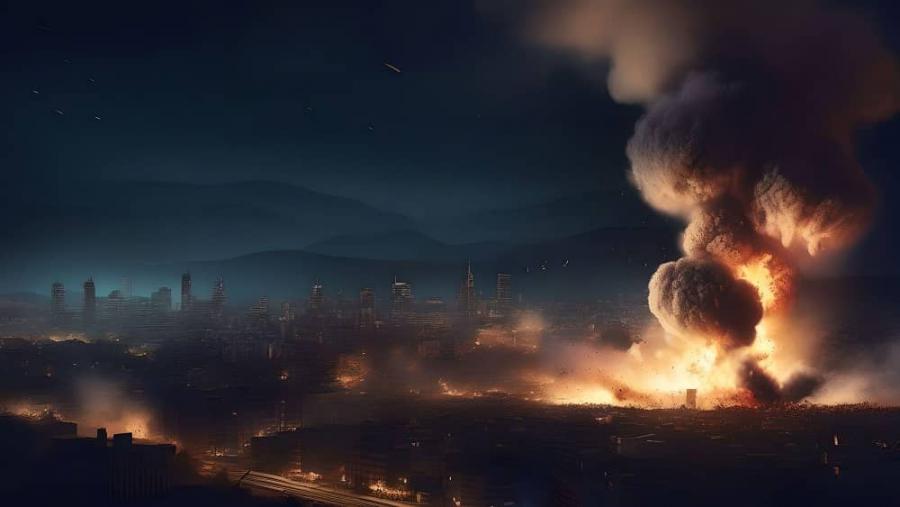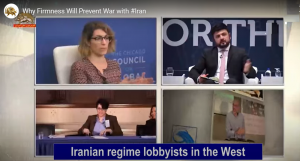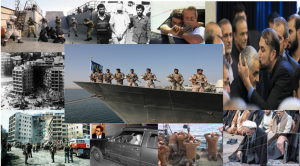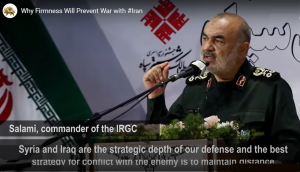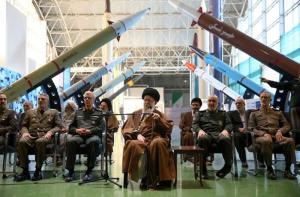
(Video) Why Firmness Will Prevent War with Iran
Throughout its history, the Iranian regime has repeatedly employed hostage-taking and terror tactics to blackmail others and to preserve its rule at home.
PARIS, FRANCE, April 25, 2024 /EINPresswire.com/ -- The National Council of Resistance of Iran (NCRI) Foreign Affairs Committee in an article published that in the aftermath of the October 7 attacks and the devastating conflict that followed, the international community faces a stark dilemma: How can the world address the Iranian regime’s enduring terrorist agenda without igniting a full-blown conflict in the volatile Middle East?
This lingering question echoes across global capitals as Tehran-backed militias cast a foreboding shadow over the region. However, the prevailing belief that countering and standing firm against Tehran’s aggressions may inevitably lead to war is a misconception a narrative woven by the Iranian regime itself. Tehran’s lobbies in the West contend that other states have to “deal” with the regime diplomatically instead of alienating it.
That approach begets more terrorism and will have disastrous consequences as the regime will perceive it as a weakness and will escalate its destructive behavior.
The regime’s history and nature show that it only moves away from aggression when faced with a firm stance. Contrary to the apprehension surrounding resolute actions, such methods are not a harbinger of war but rather a strategic imperative in quelling Tehran’s aggression.
Iran’s regional strategy
The Iranian regime’s survival is dependent on two critical pillars: suppression at home, and spreading terrorism and warmongering abroad. The regime’s Middle East strategy revolves around the concept of “strategic depth,” which involves fostering regional influence through the support of proxy militias and non-state actors.
More importantly, the regime’s internal challenges, including economic hardships and political unrest, further fueled its desire to project power beyond its borders. Tehran firmly believes that suppressing domestic dissent becomes more manageable when attributed to a foreign enemy.
By supporting proxy groups, Iran aims to venture its influence into strategically important regions, such as Lebanon, Syria, Yemen, Iraq, and even North Africa. These militias serve as surrogate forces, carrying out Iran’s objectives without directly implicating the Iranian military.
The use of proxy militias has been particularly effective in Lebanon, where Hezbollah has emerged as a powerful political and military force. In Syria, Iran has played a central role in propping up the Assad regime, providing military assistance and financial support. Iraq, too, has witnessed Iranian influence through the support of Shiite militias.
This strategy allows Iran to maintain plausible deniability, expanding its reach and influence while obscuring the lines of accountability. This has made it increasingly difficult to address the root causes of regional instability, which works to the advantage of Tehran.
However, this concept is inherently self-revealing: The extensive network of paramilitary forces maintained by the Iranian regime functions as a powerful symbol of perceived strength, projecting an image of invincibility to gain concessions from the West.
The regime’s lobby then builds arguments atop this perception, concluding that Tehran’s ruling mullahs are here to stay and must be appeased. Nevertheless, the regime’s true military capabilities are constrained, and its dependence on proxy forces underscores an intrinsic weakness and vulnerability.
Ironically, as Tehran continues to wreak havoc in the Middle East, Iranian officials consistently maintain that Iran is the safest and most stable country in a tumultuous region. Supreme Leader Ali Khamenei underscores this perspective on a dedicated page on his website, famously contending, “If we don’t confront the enemy beyond our borders, we will inevitably face them within our cities.”
Contrary to what it endeavors to portray globally, Iran has not faced external adversaries in the last three decades. Instead, it has been engaged in a relentless struggle with its population. For years, the regime has faced a primary adversary in the form of a sustained uprising that cuts across geographical, ethnic, religious, class, and gender lines.
What do Iranian officials think about war?
Over the last three decades, the regime has spent billions of dollars on a nuclear weapons program and a diverse ballistic missile program, both geographically dispersed across the country. Tehran also regularly orchestrates war games, and military parades, and conducts cyber operations worldwide to showcase the regime’s capacity and present itself as more powerful than it is.
Tehran apologists and lobbyists argue that the US risks war if it stands firm against the regime. However, despite all its military investments and bold rhetoric, the regime is well aware that a war with the US is exactly the opposite of the regime’s strategy for survival, that is why it pursues its goal by its proxies.
The regime’s objective through its malevolent activities in the regions is discernible in various statements made by its officials. For instance, Supreme Leader Ali Khamenei has emphasized the connection between involvement in Syria and potential conflicts within Iran, stating, “If we do not engage in Syria, we may face battles in Kermanshah, Hamadan, and other Iranian provinces.”
Commander of the Islamic Revolutionary Guards Corps (IRGC), Salami, emphasizes the regime’s strategy, stating, “Syria and Iraq constitute the strategic depth of our defense, and the optimal approach in conflict with the enemy is to maintain distance.”
Foreign Minister Amir Abdollahian reinforces this perspective, stating, “Today, if we do not defend Gaza, we must defend our cities.” These statements collectively highlight the regime’s approach to utilizing proxy conflicts to pursue its strategic goals.
The most stark admission came from Khamenei in August 2018, at the peak of political tensions with the US during Donald Trump’s presidency, told a crowd of his followers, “In short, to the Iranian people: there will be no war, and we will not negotiate.
Why? Because war involves two sides: we, who do not initiate conflict, and the Americans, who also refrain from starting a war as they know it would be entirely to their disadvantage. Americans once attacked us in Tabas [referring to a military operation by US forces to rescue American hostages in 1981] and retreated! There will be no war, without a doubt.”
Forcing Tehran to stand down
Throughout its history, the Iranian regime has repeatedly employed hostage-taking and terror tactics to blackmail others and to preserve its rule at home.
This calculated strategy has often resulted in the world caving into Tehran’s demands, providing concessions that have bolstered the regime’s influence and emboldened its aggression. However, in rare instances where resolute action has been taken against Tehran’s provocations, it has not resulted in war but rather forced the regime to back down and recalibrate its approach.
In March 2007, fifteen Royal Navy personnel were seized by Iranian forces in the Persian Gulf. The UK government maintained that the sailors were operating in Iraqi waters, while Iran claimed they were in Iranian territorial waters.
The UK government issued a warning of “robust” action against further breaches of international law. The UK also deployed additional warships to the Persian Gulf and conducted heightened military exercises. After 13 days, Iran released the sailors, and the regime’s president Mahmoud Ahmadinejad personally accompanied them during their departure from Tehran.
This pattern of behavior suggests that the Iranian regime is unwilling to risk a confrontation with the US military or other Western nations. It also shows that the regime only understands the language of force and will back down when faced with a decisive and firm policy.
The menace posed by the Iranian regime in the Middle East is not a result of its inherent strength but rather stems from the West’s weakness in addressing it. Over the past four decades, Western policy has predominantly been one of appeasement towards the Iranian regime, rendering it a potent force in the region.
Decades of Western appeasement have provided the Iranian regime with ample opportunities for its disruptive activities in the region. The historical complacency of the West has unintentionally facilitated Iranian regime-sponsored terrorism.
A chronicle of four decades marked by hostage-taking and terrorism highlights that yielding to the leading state sponsor of terrorism only strengthens the fundamentally corrupt and extremist regime.
Since the early 1980s, the Iranian Resistance has consistently warned the world about the dangerous nature and agenda of the Iranian regime. Despite these alerts, the international community has witnessed this perilous entity grow and expand its influence unchecked, infiltrating deep into the social fabric of various societies. In return for their efforts, the resistance movement not only received minimal credit but also faced brutal and multifaceted repression from Western powers.
The solution to addressing the regime lies in dealing decisively with it. A “decisive deal” does not involve resorting to war but, instead, calls for ending the policy of appeasement and adopting a resolute stance against the Iranian regime.
Tehran’s strategic messaging and its global impact
A prevalent perception suggests that due to the formidable power of the Iranian regime, derived from its strategic positioning in the predominantly Muslim Middle East, the international community refrains from holding the regime accountable for its malign actions, fearing potential repercussions that could inflame the entire region. However, this misperception is not a recent development; rather, it has evolved over more than three decades as a carefully crafted doctrine originating from narrative-shaping centers in Tehran.
To manipulate public opinion and influence policymaking, the Iranian regime has employed various strategies to promote the narrative that any firm policy against it will inevitably escalate into a full-fledged military conflict.
These efforts have been spearheaded by the regime’s lobby arms in the West and individuals who self-identify as “Iran experts.” These figures have actively engaged in media appearances, academic lectures, public statements, and op-eds to disseminate this message, often portraying themselves as proponents of peace and non-interventionism.
Their communication strategy often involves exaggerating the military strength and geopolitical influence of the Iranian regime, obscuring Tehran’s vulnerabilities, inflating the political significance of the regime’s proxy forces in the region, diminishing the roles of other Middle Eastern countries, presenting overly optimistic scenarios regarding the impact of diplomacy with Tehran, amplifying perceived domestic support for the regime, and discouraging legislative or executive actions against the clerical dictatorship.
In a special report on December 1, 2018, Reuters wrote, “[There are] more than 70 websites found by Reuters which push Iranian propaganda to 15 countries, in an operation that cybersecurity experts, social media firms and journalists are only starting to uncover.
The sites found by Reuters are visited by more than half a million people a month and have been promoted by social media accounts with more than a million followers.”
In May 2019, FireEye released a report exposing an Iranian information campaign that involved social media accounts posing as Americans even going so far as publishing opinion letters in American news outlets under the same fake personas.
During a cabinet meeting on March 25, 2020, former Iranian president Hassan Rouhani openly disclosed Tehran’s propaganda initiatives aimed at shaping public sentiment regarding sanctions against the Islamic Republic.
Rouhani proudly informed his top aides, “Our Foreign Ministry has initiated a comprehensive campaign to sway public opinion and reject sanctions. Our focus is on repatriating funds seized in other countries.”
Over the years, Iranian leaders have honed their skills in conducting a shadow war. The reliance on proxy forces as the primary extension of their military abroad is complemented by the utilization of foreign agents in the West to influence policies in their favor.
They leverage their advocates on the global stage to evade accountability for their crimes and promote the narrative that the only way to avoid a war is to compromise with Iran.
Conclusion
Addressing the persistent threat posed by the Iranian regime requires a strategic shift beyond conventional containment and tactical military responses.
It is crucial to recognize that Tehran’s aggressive actions stem from a survival strategy deeply rooted in internal vulnerabilities rather than a quest for global dominance through regional warfare. The cyclical nature of Tehran’s behavior underscores the need for a more nuanced and comprehensive policy in the West.
The clerical regime has balanced its apparatus on two pillars: internal suppression and the cultivation of crises and warmongering abroad. These two pillars serve the regime’s preservation. However, fostering crises does not necessarily imply direct warfare with the United States or the West.
Engaging in direct conflict with the United States would undoubtedly result in the regime’s defeat, contradicting the regime’s strategic approach to self-preservation. Therefore, fundamentally, the regime is not inclined towards war with the US.
The regime’s lobbyists say that a decisive confrontation with the regime would exacerbate the crisis and push the regime into war. This is a baseless claim. Historical instances have shown that wherever decisive action has been taken against the regime, it has retreated. In contrast, when confronted with a softer approach, the regime becomes more assertive, intensifying its destructive behavior.
The regime perceives its stability as contingent on the chaos and turmoil experienced by other nations. If the global community genuinely seeks a solution for lasting peace and stability, it must address the two fundamental pillars of the regime’s survival strategy.
To tackle this issue, the West should terminate its four decades of appeasement policy towards the Iranian regime and align itself with the Iranian people and their legitimate resistance movement to bring about a regime change.
If you wish to receive the NCRI weekly Newsletter, please use the following link to subscribe: https://bit.ly/3SMgEla.
Shahin Gobadi
NCRI
+33 6 61 65 32 31
email us here
If the global community genuinely seeks a solution for lasting peace and stability, it must address the two fundamental pillars of the regime’s strategy.
EIN Presswire does not exercise editorial control over third-party content provided, uploaded, published, or distributed by users of EIN Presswire. We are a distributor, not a publisher, of 3rd party content. Such content may contain the views, opinions, statements, offers, and other material of the respective users, suppliers, participants, or authors.

